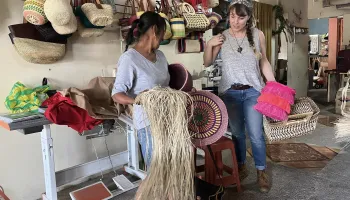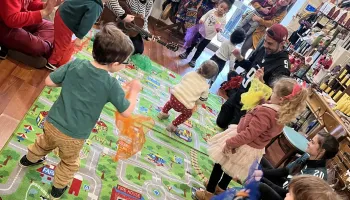Woman owned, Fair Trade in our Downtown
Partnering with artisans and growers to bring ethically produced, fair trade goods to our local economy.

Project Description
I've taken a risk for myself, for Haddon Heights, and for my fellow makers around the world. In October I purchased a fair trade retail business from its founder who was ready to retire. The shop promotes a mission that I connect with deeply. As a fully fair trade business, all of our products are purchased according to the fair trade principles put out by the Fair Trade Federation. We ensure that all of the artists and growers represented in our shop are paid a living wage up front, experience safe, reasonable working conditions, and have a capacity for growth. We reject all forms of child labor and require environmental stewardship at all steps of the production process. Fair trade traditionally partners with makers in the developing world, providing access to a market for quality goods under fair conditions. Much of the product is purchased directly from artists, and I've already visited Guatemala and Ecuador to develop these partnerships.

We are deeply connected to our local community. Our Toddler and Family African music class brings in a demographic that we don't often see in the shop and allows us to educate about the cultural contexts of our products. We host an up cycled jewelry event to teach community members about the jewelry making methods they see in the shop and encourage environmental responsibility. Our local high school has a work-based learning program, and we've worked with these students to impart practical work skills here in the shop. These are just a few examples of the way My Fair Trade Lady works passionately to engage the community in our mission.

My husband and I are public school teachers (I have resigned since buying the shop) and we needed to take out a significant SBA loan to purchase the business. This is quite a large amount of debt for us and although the shop is growing from recent years, we put all of our profits back into growing the shop and paying back the loan. It is very challenging being a mother of three who works full time, but doesn't bring in an income to justify it. If we had funds that we could use without the burden of paying back a loan, we could advertise in such a way that we would expand the current customer base at the shop. Most of our customers are walk-ins and women over 50. There are many other demographics that would connect with the shop and its mission if it were on their radar. We could also expand our online orders. We have a fully functioning website with all of our product available for purchase online, but we need to invest in making that visible and accessible to online buyers. Finally, I need to replace our flooring in the shop. There was a flood before I purchased the business and while I rent the space, it is the tenant's responsibility to maintain the interior of the building. Currently the floor is uneven and presents a significant tripping hazard, but replacing it is expensive.
Updates
The Campaign FAQs
As awareness of Fair Trade grows, so do misconceptions. These are some popular myths about Fair Trade and the realities behind them.
Myth: Fair Trade is about paying developed world wages in the developing world.
Reality: Wages are designed to provide fair compensation based on the true cost of production, and are not based on any developed world (North American or European) wage standards.
Fair wages are determined by a number of factors, including:
- The amount of time, skill, and effort involved in production
- Minimum and living wages where products are made
- The purchasing power in a community or area
- Other costs of living in the local context
Myth: Fair Trade siphons off American or European jobs (or any developed country) to other countries.
Reality: Fair Trade seeks to improve the lives of the poorest of the poor who frequently lack alternative sources of income. Most Fair Trade craft products stem from cultures and traditions which are not represented in North American or European production. Most Fair Trade food products do not have North American or European-based alternatives.
Also, as Fair Trade Organisations in developed countries grow as successful small businesses, they employ more and more individuals in their communities.
Myth: Fair Trade is anti-globalisation.
Reality: International exchange lies at the heart of Fair Trade. Fair Trade Organisations seek to maximise the positive elements of globalisation that connect people, communities, and cultures through products and ideas. At the same time, they seek to minimise the negative elements that result in lower labor, social, and environmental standards which hide the true costs of production.
Myth: Fair Trade is a form of charity.
Reality: Fair Trade promotes positive and long-term change through trade-based relationships which build self-sufficiency. Its success depends on independent, successfully-run organisations and businesses–not on handouts. While many Fair Trade Organisations support charitable projects in addition to their work in trade, the exchange of goods remains the key element of their work.
Myth: Fair Trade results in more expensive goods for the consumer.
Reality: Most Fair Trade products are competitively priced in relation to their conventional counterparts. Fair Trade Organisations work directly with producers, cutting out middlemen, so they can keep products affordable for consumers and return a greater percentage of the price to the producers.
Myth: Fair Trade results in low quality products for the consumer.
Reality: While handmade products naturally include some variation, Fair Trade Organisations continuously work to improve quality and consistency. Through direct and long-term relationships, producers and Fair Trade Organisations dialogue about consumer needs and create high quality products. Fair traders have received awards at the international Cup of Excellence and Roaster of the Year competitions, SustainAbility in Design, the New York Home Textile Show, and other venues.
Myth: Fair Trade refers only to coffee and chocolate.
Reality: Fair Trade encompasses a wide variety of agricultural and handcrafted goods, including baskets, clothing, cotton, home and kitchen decor, jewelry, rice, soap, tea, toys, and wine. While coffee was the first agricultural product to be certified Fair Trade in 1988, Fair Trade handcrafts have been sold since 1946.
Adapted from Fair Trade Federation’s original article.
Just Because I Care
Are you a #friendoffairtrade? We are so grateful for people like you who "walk-the-walk" and we will proudly shout it from the rooftops on our social media platforms! Our instagram @Julia_ranson_mooney has 10.5k followers and our Facebook has a truly engaged following. Let us share your name, product, service, etc. and show our gratitude for your support!
Rewards
Just Because I Care
Are you a #friendoffairtrade? We are so grateful for people like you who "walk-the-walk" and we will proudly shout it from the rooftops on our social media platforms! Our instagram @Julia_ranson_mooney has 10.5k followers and our Facebook has a truly engaged following. Let us share your name, product, service, etc. and show our gratitude for your support!